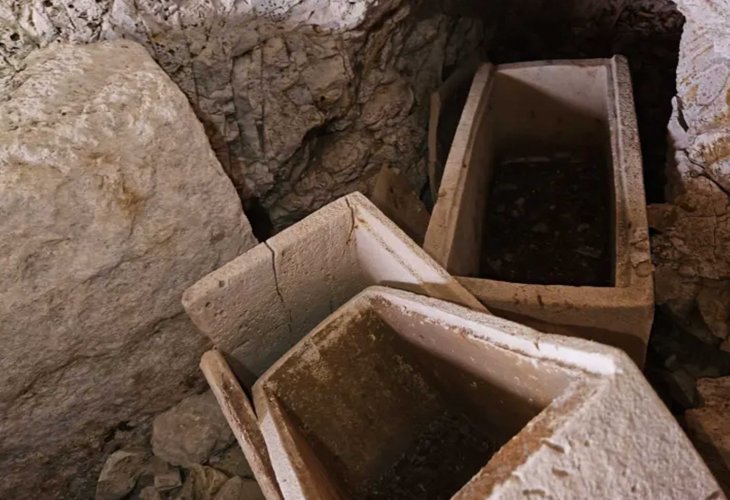Echoes from Bar Kochba: Unearthing 2,000-Year-Old Burial Caskets
Ancient burial caskets adorned with Jewish motifs discovered in Israel offer clues about a Jewish settlement dating back millennia.
 The burial caskets found in the cave at Mashhad (Photo credit: Nir Distelfeld, Israel Antiquities Authority)
The burial caskets found in the cave at Mashhad (Photo credit: Nir Distelfeld, Israel Antiquities Authority)In a collaborative effort between the Kfar Kanna Police and the Anti-Robbery Unit of the Israel Antiquities Authority, an astonishing discovery linked to the Bar Kochba revolt period was made. Investigating intelligence leads, officers from the Kfar Kanna station and inspectors from the Antiquities Authority arrived at a privately-owned plot in the Mashhad regional council. To their surprise, they discovered that extensive infrastructural work using heavy machinery had completely destroyed the ancient burial cave found on the site, leaving only a single burial niche intact.
Inspectors from the Antiquities Authority's Anti-Robbery Unit noticed several piles of earth in the plot, seemingly concealing something beneath. The landowner and construction manager were asked to remove the soil, revealing an ancient rock-hewn burial cave with nine burial niches.
At the cave's entrance, inspectors were struck by the presence of three ornately decorated stone ossuaries, once used for gathering human bones. These ossuaries were found empty and out of place, raising immediate suspicion of a recent attempt at antiquities theft. Construction work at the site was halted, and several individuals were summoned for police questioning on suspicion of damaging antiquities and failing to report a discovery. In parallel, the Antiquities Authority conducted documentation and removal of the ancient finds to prevent further theft and vandalism.
Dr. Eitan Klein, deputy director of the Anti-Robbery Unit at the Israel Antiquities Authority, explained, "The ossuaries are crafted from soft limestone, rectangular in shape, with flat lids custom-fit to each box. These ornately decorated boxes served the Jewish populations of the Galilee during the 2nd and 3rd centuries CE. The carvings feature motifs related to Jewish burial customs, influenced by Greek culture; one box depicts a mausoleum-like structure, with a circular wreath on the other side containing drilled holes, possibly symbolizing triumph over death. Such designs are characteristic of stone ossuaries used by the Jewish inhabitants of the Galilee during the Middle Roman period. Similar decorative motifs have been found on ossuaries at the Sepphoris site."
Klein added, "In Israel's archaeological research, stone ossuaries are considered an exclusive Jewish burial feature from the late Second Temple period—primarily from the 1st century BCE up to the Bar Kochba revolt in the 2nd century CE. The use of ossuaries gained prevalence during this era in the Jerusalem region, the Judean hills, and lowlands, with most production occurring in workshops around Jerusalem. This burial custom spread to the Galilee following the Bar Kochba revolt's failure and the Jewish population's migration to the area from Judea. The find of decorated stone ossuaries in a cave at Mashhad indicates a Jewish settlement there during the 2nd and 3rd centuries CE."
Amir Ganor, director of the Anti-Robbery Unit at the Israel Antiquities Authority, reported, "In this case, there is a suspicion of severe antiquities damage. The perpetrators destroyed an entire ancient burial cave and were allegedly in the midst of looting another. We will never know what the destroyed cave looked like—or what was inside and vanished. Almost 2,000-year-old cultural treasures were lost forever. Thanks to the vigilance and decisive action of Kfar Kanna police, along with successful collaboration with the Antiquities Authority, one of the caves was preserved. With the ancient finds uncovered on the site, we can salvage a fragment of the archaeological and historical information about the site and the ancient settlement."
Eli Eskosido, director of the Israel Antiquities Authority, stated, "Israel is home to about 35,000 archaeological sites. Each site is a world in itself, containing information on thousands of years of human history. The cave destruction in the north caused irreparable damage. I urge the public to remain vigilant and assist the Antiquities Authority by reporting suspicious activities involving excavation or construction in areas at risk of damaging antiquities. In this way, the public serves as our 'eyes in the field.' Together, we can protect our national treasure—Israel's heritage sites."

